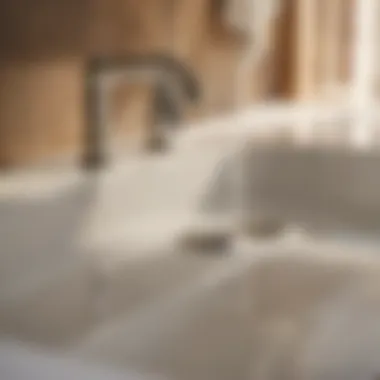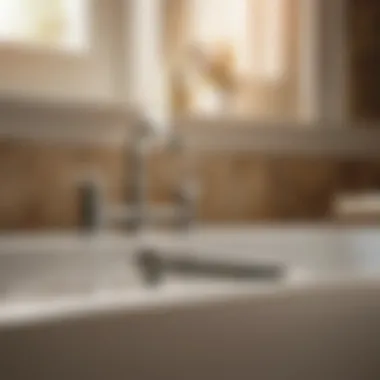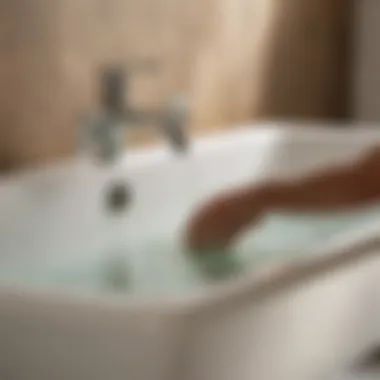Unveiling the Art of Bath Drain Fittings: A Comprehensive Insight


Materials:
- PVC drain fittings (2 inches diameter)
- Pipe wrench
- Plumber's putty
- Pipe joint compound
- Saw
- Screwdriver
- Tape measure
DIY Steps:
- Start by measuring the length of the drain pipe from the bathtub to the main drain line.
- Use a saw to cut the PVC drain fittings to the required length.
- Apply plumber's putty around the edges of the fittings to create a watertight seal.
- Use a pipe joint compound to secure the connections between the fittings.
- Attach the fittings to the drain pipe using a pipe wrench.
Technical Aspects:
- Tools required: Pipe wrench, saw, screwdriver, tape measure
- Timing specifics: Allow 2-3 hours for complete installation
- Critical techniques: Ensure all connections are tightly secured to prevent leaks
DIY Project Process:
- Insert the prepared fittings into the existing drain pipe following the measurements.
- Tighten the connections using a pipe wrench to ensure a secure fit.
- Test the drain by running water to check for any leaks or issues.
- Troubleshooting Tips: If leaks are detected, disassemble and reapply plumber's putty before reconnecting.
- Enjoy your newly installed bath drain fittings that work seamlessly!
Understanding Bath Drain Fittings
In this extensive article on bath drain fittings, understanding the nuances of these components is paramount. Bath drain fittings play a crucial role in ensuring proper water drainage, preventing clogs, and enhancing the overall aesthetics of your bathroom space. A comprehensive grasp of different types, functions, materials, installation methods, and maintenance tips is essential for anyone looking to optimize their bath fittings.
Types of Bath Drain Fittings
Pop-up Drains
Pop-up drains are a popular choice due to their ease of use and efficient water drainage mechanism. These drains feature a stopper that can be easily raised or lowered by simply pushing or pulling a lever. The key characteristic of pop-up drains is their versatile design, which allows users to control the water flow effortlessly. While they are relatively simple to operate, pop-up drains may require periodic cleaning to prevent clogs.
Toe-touch Drains
Toe-touch drains offer a hands-free solution for opening and closing the drain, making them convenient for users who prefer a touchless operation. The unique feature of toe-touch drains is their design that enables users to activate the drain by simply pressing it with their foot. This not only adds a touch of modernity to the bathroom but also reduces the risk of spreading germs. However, toe-touch drains may be more complex to install compared to other types.
Lift-and-turn Drains
Lift-and-turn drains are known for their traditional yet effective functionality. These drains require users to lift and turn the stopper to open or close the drain, providing a secure seal to prevent water leakage. The key characteristic of lift-and-turn drains is their durability, making them a reliable choice for long-term use. While they offer a classic appeal, lift-and-turn drains may require occasional maintenance to keep them operating smoothly.


Functions of Bath Drain Fittings
Ensuring Proper Water Drainage
Proper water drainage is vital for any bath drain fitting to function effectively. Ensuring proper water drainage not only prevents standing water in the bathtub but also helps maintain a hygienic environment by avoiding stagnant water. The key characteristic of proper water drainage is that it helps prevent mold and mildew buildup, prolonging the lifespan of the drain fittings. While it's essential for optimal functionality, proper water drainage also contributes to a pleasant bathing experience.
Preventing Clogs
Preventing clogs is another critical function of bath drain fittings as it helps maintain a free-flowing drainage system. By selecting fittings that come with clog-prevention features such as built-in filters or self-cleaning mechanisms, homeowners can minimize the risk of blockages. The unique feature of clog prevention is its ability to keep the drainage system clear and efficient, reducing the need for frequent maintenance. While preventing clogs enhances overall plumbing performance, it also saves time and effort in dealing with drainage issues.
Enhancing Aesthetics
Apart from functionality, bath drain fittings also play a significant role in enhancing the aesthetics of your bathroom space. Choosing fittings that complement the design theme of the bathroom can elevate its visual appeal and create a cohesive look. The key characteristic of aesthetically pleasing fittings is their ability to blend seamlessly with the overall decor, whether it's contemporary, traditional, or minimalist. By paying attention to the design and finish of the fittings, homeowners can create a harmonious atmosphere that adds to the overall ambiance of the bathroom.
Materials Used in Bath Drain Fittings
Plastic
Plastic is a common material used in bath drain fittings due to its affordability and versatility. The key characteristic of plastic fittings is their lightweight nature, making them easy to install and maintain. While plastic fittings are budget-friendly, they may not offer the same level of durability as metal options. However, with proper care and maintenance, plastic fittings can provide reliable performance for a considerable period.
Brass
Brass fittings are favored for their durability and corrosion resistance, making them a popular choice for bath drains. The key characteristic of brass is its robust quality, which ensures longevity and reliability in moisture-prone environments. While brass fittings may come at a higher price point compared to other materials, their premium finish and sturdiness justify the investment. By opting for brass fittings, homeowners can enjoy both functionality and aesthetics without compromising on quality.
Stainless Steel
Stainless steel is a premium choice for bath drain fittings, known for its strength and resistance to rust and corrosion. The key characteristic of stainless steel fittings is their durability, making them ideal for high-traffic bathrooms or those exposed to moisture regularly. While stainless steel fittings may require a higher initial investment, their long-term benefits in terms of longevity and low maintenance make them a worthwhile choice. By selecting stainless steel fittings, homeowners can achieve a sleek and modern look while ensuring reliable performance for years to come.
Installing Bath Drain Fittings
In this comprehensive guide to exploring bath drain fittings, the section on installing bath drain fittings plays a critical role in ensuring the functionality and longevity of your bathroom features. The installation process is where carefully selected fittings come together to form a cohesive system that facilitates proper water drainage, prevents potential clogs, and enhances the overall aesthetic appeal of your bath space.
DIY Installation Guide
Tools Required


When it comes to DIY installation of bath drain fittings, having the right tools is essential for a successful outcome. The tools required for the installation process may include a wrench, screwdriver, plumber's putty, pipe tape, and pliers. These tools contribute significantly to the overall ease and efficiency of the installation, allowing homeowners to tackle the project with confidence.
The key characteristic of these tools is their versatility and durability, making them a popular choice for DIY enthusiasts looking to set up their bath drain fittings. Their unique features, such as adjustable grips and corrosion-resistant materials, offer distinct advantages in terms of ease of use and long-term reliability within the context of this article.
Step-by-Step Process
The step-by-step process involved in installing bath drain fittings is a systematic approach that guides individuals through each stage of the installation with precision and clarity. From preparing the area to connecting the drains and ensuring proper sealing, this process is crucial in achieving a seamless and functional result.
The key characteristic of this process is its clear and structured nature, which eliminates guesswork and minimizes errors during installation. Its step-by-step format is a beneficial choice for this article as it empowers readers with the knowledge and confidence to undertake the installation themselves. The unique feature of this process lies in its detailed instructions and visual aids, which enhance comprehension and reduce the likelihood of potential issues, leading to a successful installation.
Professional Installation Services
When opting for professional installation services for bath drain fittings, homeowners can enjoy various benefits that elevate the installation experience. Professional installers bring expertise, efficiency, and precision to the table, ensuring that fittings are correctly installed and seamlessly integrated into the existing plumbing system.
Benefits
The benefits of professional installation services include access to specialized knowledge and skills, personalized recommendations based on individual needs, and timely completion of the installation process. These key characteristics make professional services a popular choice for homeowners seeking a hassle-free and expertly executed installation of their bath drain fittings.
The unique feature of these services lies in the guarantee of quality workmanship and adherence to industry standards, offering distinct advantages in terms of reliability and long-term performance within the scope of this article.
Cost Considerations
When considering the cost of professional installation services for bath drain fittings, it is essential to weigh the upfront investment against the long-term benefits and peace of mind that come with professional installations. While the initial cost may be higher than a DIY approach, the value gained from expert installation, warranty coverage, and potential savings on future repairs or modifications can offset the initial expense.
The key characteristic of cost considerations in professional installations is the transparent pricing structure and the breakdown of costs involved, allowing homeowners to make informed decisions and budget accordingly. This feature is a beneficial choice for this article as it highlights the importance of considering all financial aspects when opting for professional installation services, ensuring a cost-effective and efficient installation process.
Maintaining Bath Drain Fittings
Maintaining bath drain fittings is a crucial aspect of ensuring the longevity and efficiency of your bathroom fixtures. In this article, we delve deep into the significance of proper maintenance practices for bath drain fittings, shedding light on specific elements that contribute to the smooth functioning of your bathroom setup. By focusing on maintenance, homeowners can extend the lifespan of their bath drain fittings, prevent costly repairs, and maintain a hygienic bathroom environment.
Cleaning and Care Tips
Regular Cleaning Practices
Regular cleaning practices play a pivotal role in upholding the functionality and appearance of bath drain fittings. By incorporating a routine cleaning schedule, individuals can eliminate soap scum, hair, and other debris that may accumulate over time. This proactive approach not only enhances the overall hygiene of the bathroom but also prevents potential clogs and drainage issues. The simplicity and effectiveness of regular cleaning practices make them a popular choice for homeowners looking to maintain their bath drain fittings effortlessly.


Avoiding Harsh Chemicals
When it comes to caring for bath drain fittings, avoiding harsh chemicals is paramount in preserving the integrity of the fixtures. Harsh chemicals can erode seals, damage finishes, and impact the overall performance of the fittings. By opting for gentle, non-abrasive cleaning solutions, homeowners can safeguard their bath drain fittings against premature wear and tear. The unique feature of avoiding harsh chemicals lies in its ability to protect both the fittings and the environment, making it an eco-friendly choice for maintenance. While harsh chemicals may offer quick results, the long-term disadvantages outweigh the short-term benefits in the context of maintaining bath drain fittings.
Preventive Maintenance
Checking for Leaks
Regularly checking for leaks is a proactive measure that aids in early detection of potential issues within bath drain fittings. By monitoring for any signs of leaks, such as water stains or dampness, homeowners can address underlying problems before they escalate. The key characteristic of checking for leaks is its ability to prevent water damage and mold growth, preserving the structural integrity of the bathroom. This practice is a beneficial choice for homeowners seeking to avoid costly repairs and mitigate extensive water damage, emphasizing the importance of regular inspections.
Inspecting Seals
Inspecting seals is a critical aspect of preventive maintenance for bath drain fittings, as seals play a vital role in preventing leaks and maintaining water-tight connections. Regular inspection allows homeowners to identify worn or damaged seals promptly, enabling timely replacements to uphold the functionality of the fittings. The unique feature of inspecting seals lies in its ability to ensure seamless operation and prevent water seepage, contributing to the overall efficiency of the bathroom setup. While inspecting seals may require periodic attention, the advantages of preserving water integrity and preventing leaks make it a valuable practice in maintaining bath drain fittings.
Troubleshooting Common Issues
Troubleshooting common issues is a critical aspect of maintaining your bath drain fittings. In this comprehensive guide, we focus on addressing and resolving issues that may arise, ensuring your fittings operate seamlessly. By understanding how to troubleshoot common problems, you can save time and money while avoiding more significant issues down the line.
Dealing with Drain Clogs
Drain clogs are a frequent nuisance that can disrupt the functionality of your bath drain fittings. When it comes to dealing with drain clogs, two primary methods are commonly used:
Using Drain Snakes
Using drain snakes is a practical and effective way to tackle stubborn clogs in your bath drain. These flexible and slender tools can reach deep into the pipes, breaking up blockages and restoring proper water flow. The key advantage of using drain snakes is their ability to target clogs directly, providing a tailored solution for different types of blockages. However, one should be cautious with drain snakes to prevent damage to the pipes.
Chemical Drain Cleaners
Chemical drain cleaners offer a quick and convenient solution for minor clogs in bath drains. These products contain powerful chemicals that can dissolve organic matter and debris, clearing the blockage efficiently. The main advantage of chemical drain cleaners is their speed and ease of use, making them a popular choice for addressing minor clogs. Nevertheless, it's essential to follow safety precautions when using chemical cleaners and avoid overuse to prevent damage to the plumbing system.
Repairing Leaky Fittings
Leaky fittings can lead to water wastage and damage to surrounding areas if not addressed promptly. In this section, we explore two common methods for repairing leaky fittings:
Replacing Seals
Replacing seals is a fundamental step in fixing leaky fittings. Seals act as barriers to prevent water leakage around joints and connections. By replacing worn-out or damaged seals, you can effectively seal the fittings and prevent water seepage. The key characteristic of replacing seals is their cost-effectiveness and simple installation process, making them a popular choice for repairing leaks. However, it's essential to choose high-quality seals to ensure longevity and leak-proof performance.
Fixing Loose Connections
Loose connections can contribute to leaks in bath drain fittings, compromising their functionality. Fixing loose connections involves tightening or securing the fittings to eliminate gaps where water can escape. The key characteristic of this method is its straightforward approach, requiring basic tools and skills to reestablish a tight seal. While fixing loose connections is relatively simple, it's crucial to ensure all connections are secure to prevent future leaks.







